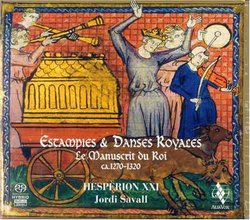| All Artists: Manuscrit du Roi Anonymous, Raimbaut de Vaqeiras, Marcabru, Jordi Savall, Hesperion XXI Title: Estampies & Danses Royales Members Wishing: 2 Total Copies: 0 Label: Alia Vox Spain Original Release Date: 1/1/2008 Re-Release Date: 5/13/2008 Album Type: Import Genres: Dance & Electronic, Special Interest, Pop, Classical Styles: Vocal Pop, Opera & Classical Vocal, Chamber Music, Historical Periods, Early Music Number of Discs: 1 SwapaCD Credits: 1 UPC: 7619986098579 |
Search - Manuscrit du Roi Anonymous, Raimbaut de Vaqeiras, Marcabru :: Estampies & Danses Royales
 | Manuscrit du Roi Anonymous, Raimbaut de Vaqeiras, Marcabru Estampies & Danses Royales Genres: Dance & Electronic, Special Interest, Pop, Classical
|
Larger Image |
CD Details |
CD ReviewsSolo fiddle music rearranged for exotic ensemble Maddy Evil | London, UK | 07/03/2010 (3 out of 5 stars) "This recording presents the complete instrumental music (estampies and dances) from the 'Manuscrit du Roi' (Paris, Bibliothèque Nationale, f.fr.844, completed c.1300), together with instrumental realisations of 3 chansons, in typically Savallian performances that exploit a sizeable ensemble of various instruments and combinations (comprising various recorders and pipes, shawms, bagpipes, lute, vielle, dulcimer and percussion). Apart from a slightly dry acoustic, Savall enthusiasts can be assured that their expectations will be fulfilled.
However, there is one major problem with this CD. Apparently, "our choice of instrumentation, character, tempo, ornamentation and improvisation was based on a study of the principal historical sources dating from the time of the manuscript" (booklet notes, p.22). Strange, then, that the resultant performances are entirely at odds with the findings of specialist musicologists (such as Christiane Schima and Kees Vellekoop) who have demonstrated convincingly that the estampie is named almost exclusively in connection with the solo vielle (fiddle) in French, Flemish and Italian sources until the middle of the 14th century. Bizarrely enough, a few of these sources are even cited by Savall, although not one of them actually mentions an ensemble (all of them name a solo fiddle - see below*): such sources include the important theoretical treatise 'De Musica' (c.1300) by Johannes de Grocheio, who links the "difficultas" of the estampie to "bonus artifex in viella". The fact that the shoulder playing position for the vielle was becoming the norm by this time is yet another problem (Savall plays between the knees, i.e. in viol position). Sources place the estampie primarily into an intimate, aristocratic milieu, and in none of these literary sources is the estampie described as a dance - a separation mirrored, in fact, by the 'Manuscrit du Roi' itself (since the designated "danses" in this source are more limited than their estampie counterparts, despite apparent similarities, and they rarely depart from the first mode). Fundamentally, the assumption that this is dance music highlights the main problem: namely, the idea that all those beautiful iconographical sources showing various dancing ensembles must surely be relevant. Unfortunately, so it would seem, they are not. Perhaps you are thinking: "Who cares...? Who really wants to hear a recital of these dances on one solo fiddle...?" If so, perhaps you should ponder whether it is actually medieval music, rather than just a modern reinvention, that interests you. I am certainly of the opinion that fussy, glitzy orchestrations (often including a separate "ouvert"/ "clos" ensemble) add nothing to these pieces, and whatever else can be said, you'll be very hard-pressed to find any evidence justifying such exotic, fantastical interpretations. * The one or two sources which might seem to support the assumption that an ensemble performance was feasible are either allegorical or unreliable, e.g. the 11 verse-long list of instruments in Machaut's 'Remède de Fortune' [before 1342], which, in any case, Machaut even introduces with the revealing qualification that "...certeinnement, il me semble qu'onques mais tele melodie ne fu veüe ne oïe..." " |

 Track Listings (15) - Disc #1
Track Listings (15) - Disc #1